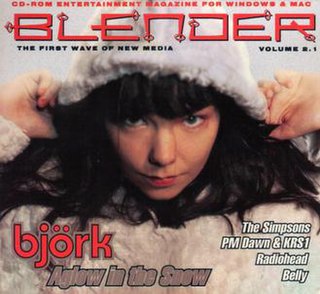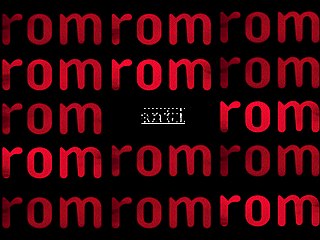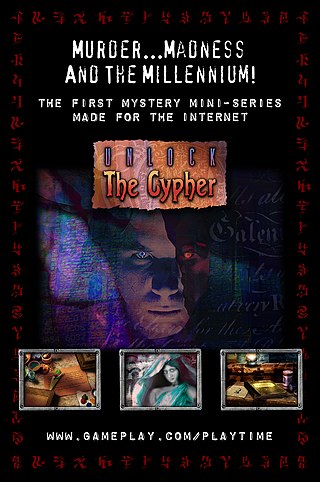Related Research Articles

The Compact Disc-Interactive is a digital optical disc data storage format as well as a hardware platform, co-developed and marketed by Dutch company Philips and Japanese company Sony. It was created as an extension of CDDA and CD-ROM and specified in the Green Book specifications, co-developed by Philips and Sony, to combine audio, text and graphics. The two companies initially expected to impact the education/training, point of sale, and home entertainment industries, but the CD-i is largely remembered today for its video games.

Blender was an American music magazine published from 1994 to 2009 that billed itself as "the ultimate guide to pop culture". It was also known for sometimes steamy pictorials of celebrities. It compiled lists of albums, artists, and songs, including both "best of" and "worst of" lists. In each issue, there was a review of an artist's entire discography, with each album being analyzed in turn.

Marc Canter is an American internet entrepreneur, speaker, technology evangelist and early pioneer of online software, and is often called the "godfather of multimedia". Canter is a CEO of Instigate, Inc. Marc is best known for being the co-founder and CEO of MacroMind, the company that became Macromedia.

Digital signage is a segment of electronic signage. Digital displays use technologies such as LCD, LED, OLED, projection and e-paper to display digital images, video, web pages, weather data, restaurant menus, or text. They can be found in public spaces, transportation systems, museums, stadiums, retail stores, hotels, restaurants and corporate buildings etc., to provide wayfinding, exhibitions, marketing and outdoor advertising. They are used as a network of electronic displays that are centrally managed and individually addressable for the display of text, animated or video messages for advertising, information, entertainment and merchandising to targeted audiences.

Behaviour Interactive Inc. is a Canadian video game developer and publisher based in Montreal. The studio is best known for the multiplayer horror game Dead by Daylight.

The Antirom art collective was formed in 1994 as a "protest against ill-conceived point-and-click 3D interfaces grafted onto re-purposed old content - video, text, images, audio and so on - and repackaged as multimedia". Its initial and most notable project, the Antirom CD-ROM, was funded by Arts Council of Great Britain and focussed on exploring interactivity in its own right, rather than being an interface to existing content such as video, audio and text.
Digital Café was a new media company founded in early 1991 by Dean Hyers and Mike Koenigs. It operated for 7 years independently in St. Paul before being acquired in October 1998 as a new Minneapolis-based division of Campbell Mithun Esty specializing in programming and design for special-market advertising similar to Black Widow Games. In 1995, Hyers and Koenigs formed a sister company to Digital Café called Digital Entertainment as a joint venture with Navarre Corporation. Digital Entertainment was then sold to Navarre Corporation in 1996.
A production artist is a technical and creative position in a creative profession. The job title originated at advertising agencies, assigning what was known as paste-up work to the position. Production artists work closely with the designer and art director to execute the design. What distinguishes "production art" from design is opportunities to utilize prepress knowledge into creativity and design training in the work involved. The degree of technical knowledge required for some production art work may be comparable to higher skilled engineering, especially with computers.
Malcolm Leslie Garrett is a British graphic designer, and Creative Director of Images&Co, a communications design consultancy based in London, UK. He is Ambassador for Manchester School of Art and co-founder of the annual Design Manchester festival, which has run since 2013.

Opération Teddy Bear is an educational comic strip video game released in 1996. It was developed by Index+ and a co-production with Flammarion, and is written by Edouard Lussan.
Creative technology is a broadly interdisciplinary and transdisciplinary field combining computing, design, art and the humanities. The field of creative technology encompasses art, digital product design, digital media or an advertising and media made with a software-based, electronic and/or data-driven engine. Examples include multi-sensory experiences made using computer graphics, video production, digital music, digital cinematography, virtual reality, augmented reality, video editing, software engineering, 3D printing, the Internet of Things, CAD/CAM and wearable technology.

the7stars is UK's largest independent media planning and buying agency. The agency provides media and advertising services to clients, including media planning and buying, creative strategy and content creation, partnerships, insight and analytics, and strategic services.

Disney's Animated Storybook is a point-and-click adventure interactive storybook video game series based on Walt Disney feature animations and Pixar films that were released throughout the 1990s. They were published by Disney Interactive for personal computers for children ages four to eight years old. Starting from 1994, most of the entries in the series were developed by Media Station. They have the same plots as their respective films, though abridged due to the limited medium.
Apadmi is an independent technology company based in Manchester. Specializing in mobile, Apadmi works with clients including Argos, the BBC, Co-op, the Guardian, NHS, Lexus, Range Rover, and United Utilities.

Jason Michael Holland is an English designer, university lecturer, writer and awards judge who created the 1997 website Head-Space, which is included in Management Today's Ten Websites That Changed the World, and is an acknowledged blueprint for intranets and a precursor to YouTube. Holland is also credited with a number of other interactive firsts.

ZOO Digital Group PLC is a provider of cloud software based subtitling, dubbing, and media localization services to the TV and movie industry. Its production facilities are located in El Segundo, Los Angeles; London and Sheffield, UK and Dubai, U.A.E. The company employs more than 500 employees worldwide and utilizes a global network of over 5,000 freelance translators and dubbing artists.

Ben Terrett is a British designer. He was the first Royal Designer for Industry elected for Service Design and has won the Design Museum's Design of the Year, a D&AD "Black Pencil" and is in the Design Week Hall of Fame. Terrett specialises in large digital projects and is most well known for his work designing the GOV.UK website.

The Cypher is an interactive fiction video game by EPG Multimedia.

Eku Wand is a German Designer and Multimedia director. Wand is a professor of media design and multimedia at the Braunschweig University of Art with a research focus on Interactive Storytelling.
Andy Cameron was a British interactive artist and writer, notable for being a founder of art collective group Antirom. He co-authored the highly cited essay The Californian Ideology with Richard Barbrook. In 2011 he received the Royal Designers for Industry award from The Royal Society of Arts.
References
- ↑ Montgomery, Angus (2012-11-12). "Tom Roope and Brian Eno among new Royal Designers for Industry". Design Week. Retrieved 2020-09-02.
- ↑ "Honorary Graduates | Alumni Community | University of Lincoln". www.lincoln.ac.uk. Retrieved 2020-09-02.
- ↑ sass (2008-02-10). "Anti-rom". Mute. Retrieved 2020-09-03.
- ↑ Grafik. "Anti Heroes". Grafik. Retrieved 2020-09-02.
- ↑ "In the beginning there was Antirom | Digital Archaeology" . Retrieved 2020-09-03.
- ↑ Pendrell, Luke (2014-07-03). "Digital Revolution (antirom)".
{{cite journal}}: Cite journal requires|journal=(help) - ↑ Campbell-Johnston, Rachel. "Here's something my robot made earlier — the new age of digital art". The Times . ISSN 0140-0460 . Retrieved 2020-09-02.
- ↑ "#iamabroadcaster Preview: Tom Roope, The Rumpus Room | AIB". aib.org.uk. Retrieved 2020-12-04.
- ↑ "How Google Zoo is thinking about machine learning". Current Daily. 2018-02-23. Retrieved 2020-08-27.
- ↑ "Google launches hieroglyphics translator powered by AI". BBC News. 2020-07-15. Retrieved 2020-08-27.